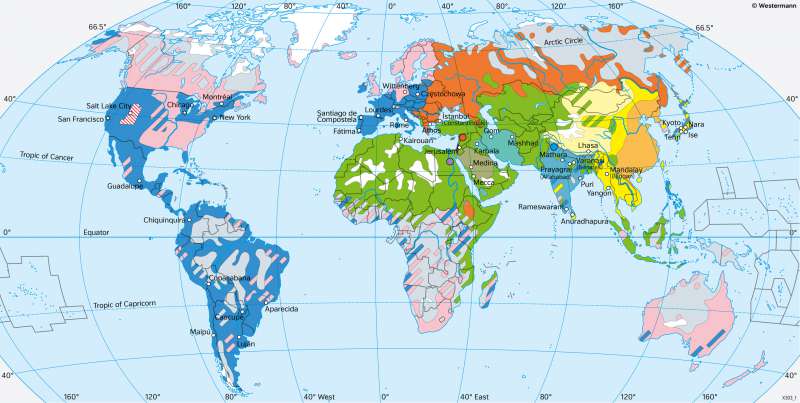The World - Religions
Religious faiths
978-3-14-100890-6 | Page 40 | Ill. 1

Overview
This world map shows the predominant religions in the regions of the world. It therefore shows that religion to which the largest proportion of the population in that region professes. However, it is also not a representation of religiosity - it is only about the affiliation to a religious community.
Christianity and Judaism
gest world religion. Christianity is especially dominant in Europe and on the American continent. Several Protestant and Catholic majorities are found in sub-Saharan Africa, most notably in the southern and western regions. On the Asian continent, Christianity is mainly represented by Orthodox and Oriental Russians and the Catholic majority in the Philippines. Nearly 20 million Christians, most of them Protestants, live in Indonesia. In Australia and New Zealand, the Anglicans and Catholics, whose communities are almost equal in size, together with Orthodox Christians make up slightly more than half of the population.
A total of 15 million people belong to the Jewish faith (0.2% of the world population). The largest number of today’s professing Jews lives in Israel. In addition, there are Jewish communities of different sizes scattered all over the world, but especially in the USA. The most important are those of New York, Chicago, and San Francisco.
Buddhism
Buddhism, especially Mahayana Buddhism, which emerged at the dawn of Christianity, and Lamaism under the leadership of the Dalai Lama, also known as Tibetan Buddhism, has spread mainly in East Asia, including large parts of China, in Myanmar, Laos, Thailand, Cambodia and Vietnam (460 million (5.6%) believers worldwide).
Other religions
Earth-centred religions that worship nature exist predominantly in regions that are very sparsely populated and where geographical remoteness, climatic unfavourability or other factors have prevented modernisation. They are found mainly natural refuges in South America, near the Arctic Circle, in Oceania, the interior regions of Australia and the southern half of Africa.
However, a map showing the distribution of religious and denominational affiliations inevitably produces a distorted picture due to the very different population densities on earth. The regional distribution hardly provides valid indications of the real significance (e.g. in the case of nature worship).
Islam
Islam has expanded in nearly every direction from the territory occupied for the most part during the 7th and 8th centuries and recruited large numbers of adherents, especially in South and South-East Asia, in northern Africa and along the African east coast. Russia marks the boundary of Islamic expansion to the north. The only Islamic majorities on the European continent are found in Turkey and Albania, while significant minorities live in Bosnia and Herzegovina, Macedonia, and Bulgaria. Worldwide, 1.8 billion people are professing Muslims (24%).
Hinduism
Hinduism, which originated from the Vedic religion, has about 940 million followers (15.1%) in India. It is closely linked to the Indian caste system. Much smaller is the number of Sikhs (27 million), a religious community founded in the 15th century, in which elements of Hinduism and Islam are mixed. Its followers live mainly in the Indian state of Punjab.




